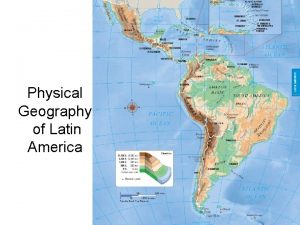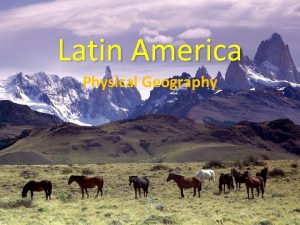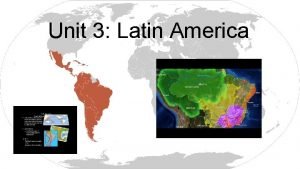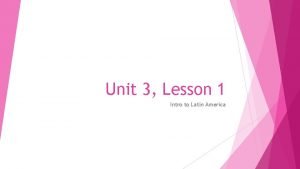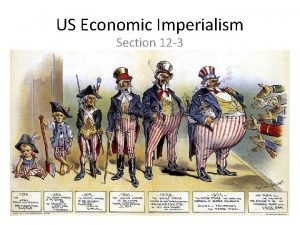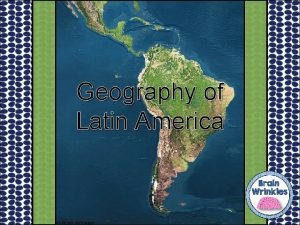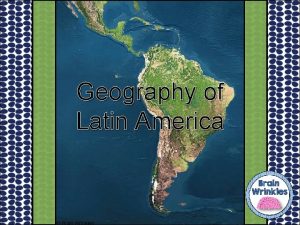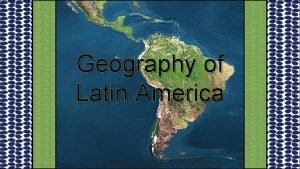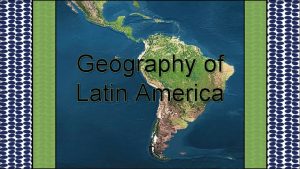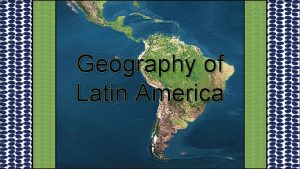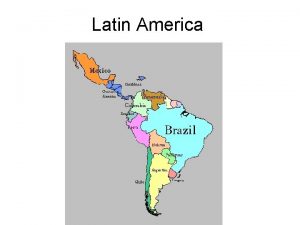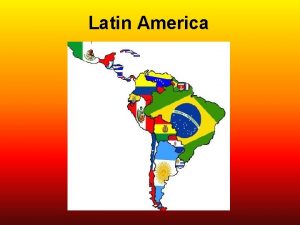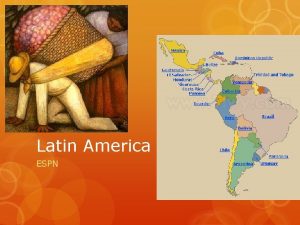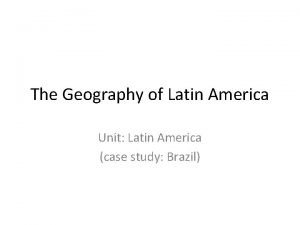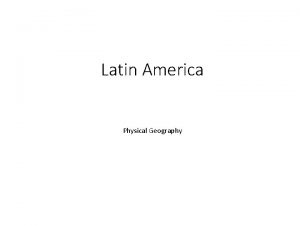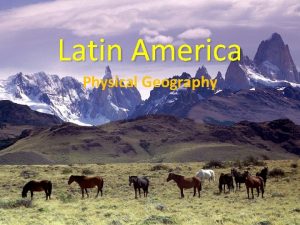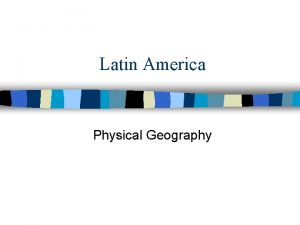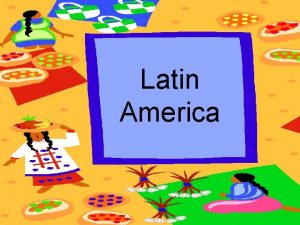Latin America Land People A review Peterson Geography

























- Slides: 25

Latin America Land People: A review Peterson – Geography - UNO

Land Ownership • How can an individual own land? – Is it possible for an individual to own a piece of the ocean? – A piece of a lake? – Is it possible to own a piece of the air? The wind? – Where does ownership begin and where does it stop?

Indigenous Land Tenure • Concept of individual land ownership – Indigenous peoples did not view land as a commodity or resource that could be owned or held – Land ownership in more advanced cultures • Usufruct – Latin: "usus et fructus, " meaning "use and enjoyment" – right to use and derive profit or benefit from property – individuals or groups only acquire the usufruct of the property, not legal land ownership

European Land Tenure – Europeans introduced the concept of land ownership in Latin America – Spanish conquistadores then Spanish colonists – Acquiring large tracts of land – Residence on hacienda and in city – Not investing in equipment – Conspicuous consumption

Latifundia • Latin: lātus, "spacious" + fundus, "farm, estate” • property covering tremendous areas • originated under colonial law allowing forced labor and land grants for military service • Haciendas, estancia (Argentina, Uruguay), fazendas (Brazil) • quasi-feudal estates • Feudalism: A system of obligations that bind the state, land owners, and workers

Encomienda • A system of forced labor employed by the Spanish crown • Granted land-owner a specified number of natives for whom they took responsibility • Land-owners could exact tribute from the natives in the form of labor, gold or agricultural products • System continued Aztec, Inca tradition of extracting tribute

Repartimiento • Natives forced to work a certain number of weeks or months each year for the Spanishowned farms • replaced the encomienda of throughout most Spanish-ruled areas by the beginning of the 1600 s • System lasted longer in Peru

Modern Slavery in Brazil • 2000 estimate: 25, 000 forced workers and slaves in Brazil • More than 1, 000 slave laborers were freed from a sugar cane plantation in 2007 by the Brazilian government • 2008, the Brazilian government freed 4, 634 slaves in 133 separate criminal cases at 255 different locations • Company store, debt, threat of violence if debt not repaid

“There was no way we could get out of there because it was so isolated. ” Debt bondage at alcohol and sugar mill. Sugarcane cutters transported in cattle truck. If these workers have no possibility of leaving. . . if they live in miserable conditions, and if they are charged more than they earn, then that to me is slavery. ~Human rights worker

Minifundia • mainly subsistence-oriented smallholdings are farmed by indigenous and peasant households • Less than 2 hectares (about 5 acres) • Squatter rights – Experience in 1930 s Colombia: – peasants, amidst the political confusion, tried to attain greater control over small plots – Law for squatter ownership of land – Squatters removed from Latifundia

Land Reform – Pro Arguments 1. Unequal distribution of land is associated with feudalism 2. End of feudalism in Europe created conditions for industrialization 3. Ethical argument: equity, inherent injustice of extreme wealth and poverty 4. Illegitimate basis of wealth (inherited land); work should be a basis of rewards 5. Quell social unrest 6. Shatter a social system that chains a large number of people to the land 7. Stimulate urban migration for industrialization 8. Give rise to new urban power elites, rather than rural elites

Land Reform 9. National integration, create a "new order" 20 th Century revolutions linked to land reform; Mexico, Russia, China, Cuba, Bolivia, Vietnam, Nicaragua, Ethiopia 10. Development (necessary to turn peasants into farmers) – end inefficient, archaic land use – create more rational use of resources (small farms can have higher productivity per unit of land labor input) – provide new incentives to majority of agricultural population to improve production

Land Reform Types • Expropriation - seizure of land for reform – Redistribution - parceling land out to workers or peasants (Mexico - Zapata: “Land or Death!”) – Collectivization or state farm management - no distribution of land (Russia, China) • Tenancy reform - change in rules governing rent and sharecropping – Example: Taiwan and Philippines • Re-settlement, colonization - movement of peasants (Brazil; Sumatra in Indonesia)

Farms vs. Land in 1970 Minifundia <2 hectares Latifundia >2 hectares % of Farms % of Land Argentina 43 3 Argentina 0. 8 37 Brazil 23 0. 5 Brazil 4. 7 60 Colombia 64 4. 9 Colombia 1. 3 50 Chile 37 0. 2 Chile 7 81 Ecuador 90 17 Ecuador 0. 4 45 Guatemala 88 14 Guatemala 0. 1 41 Peru 88 7 Peru 1. 1 82

Mexico’s Ejido • 1922 Law: Hacienda lands expropriated and given to ex-workers to manage. • Collective ownership of Ejido land • permanent use rights (inheritance, use) • no sale or rental • non-partible (family plot cannot be subdivided for children)

Mexico’s Ejido • 1940 - 53% of all Mexican agricultural land is in Ejido • 1960 - 40% of land in Ejido (new lands not subject to Ejido). • 1992 – Ejido associated with backward, peasant agriculture; formally abolished by neo-liberals – neoliberalism seeks to transfer part of the control of the economy from public to the private sector, under the belief that it will produce a more efficient government and improve the economic health of a nation.

Income Distribution • Lorenz curve - graphic representation of unequal distribution of income, land or or other measure of wealth • shows that small percent of population has most wealth and large percent has only a small portion of the wealth • Gini coefficient - a measure of inequality of income or wealth

Lorenz Curve • a graphical representation of the cumulative distribution function of the empirical probability distribution of wealth • it is a graph showing the proportion of the distribution assumed by the bottom x% of the households • used to represent income distribution, where it shows for the bottom x% of households, what percentage y% of the total income they have.


Gini Coefficient • defined mathematically based on the Lorenz curve • ratio of the area that lies between the line of equality and the Lorenz over the total area under the line of equality G=A/(A+B).

Gini Coefficent = A/(A+B)

Gini Coefficient Gini coefficients for income range from approximately 0. 247 in Denmark to 0. 707 in Namibia


Land Colonization • Spontaneous • Directed • Semi-directed

Agrarian Transformation • Maximizing export trade • Generating foreign currency revenues • Exploit competitive advantage of a country – Producing fruit in the off-season for the Northern Hemisphere
 Why is called latin america
Why is called latin america Sensory memort
Sensory memort Physical features of south america
Physical features of south america Voluntary trade comprehension check
Voluntary trade comprehension check South america highlands
South america highlands Vocabulary activity 9 cultural geography of latin america
Vocabulary activity 9 cultural geography of latin america Traje tipico de soloma
Traje tipico de soloma Chapter 8: the physical geography of latin america answers
Chapter 8: the physical geography of latin america answers Amazon river
Amazon river An area of land largely enclosed by higher land
An area of land largely enclosed by higher land A pointed piece of land extending into the sea
A pointed piece of land extending into the sea European claims in north america
European claims in north america Where was christopher columbus trying to go
Where was christopher columbus trying to go We can do a rap of the map of the us
We can do a rap of the map of the us North america south america europe asia
North america south america europe asia Whats an onomatopeia
Whats an onomatopeia Happening e performance
Happening e performance Geography grade 12 settlement questions and answers
Geography grade 12 settlement questions and answers Mixed land use ap human geography definition
Mixed land use ap human geography definition Heartland ap human geography definition
Heartland ap human geography definition Terra latin declension
Terra latin declension South america facts geography
South america facts geography Physical geography of south america webquest
Physical geography of south america webquest Lesson 1 physical geography of south america
Lesson 1 physical geography of south america Penisulares
Penisulares South american map
South american map


